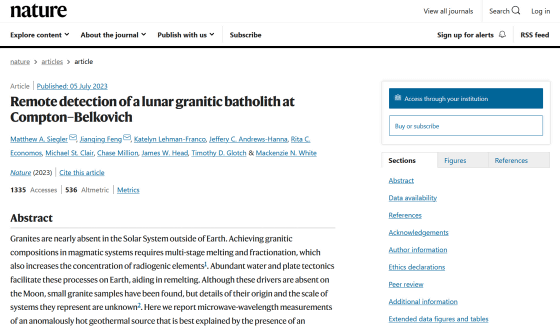It turns out that there is a ``gigantic rock mass that releases heat'' on the back side of the moon, is it a remnant of former volcanic activity?

The moon has no atmosphere to soften the heat of the sun or retain heat on its surface, so during the day the sun hits the surface, the surface temperature reaches 110 degrees Celsius, while at night the surface temperature cools to -170 degrees Celsius. . However, a new study that analyzed observation data on the far side of the moon revealed that there is a ``massive heat-releasing rock mass'' with a diameter of about 50 km on the far side of the moon.
Remote detection of a lunar granitic batholith at Compton–Belkovich | Nature

Scientists discover large granite mass buried | EurekAlert!
https://www.eurekalert.org/news-releases/994740
Scientists discover huge, heat-emitting blob on the far side of the moon | Live Science
https://www.livescience.com/space/the-moon/scientists-discover-huge-heat-emitting-blob-on-the-far-side-of-the-moon
A research team led by Matt Ziegler , a researcher at the Institute for Planetary Science in Tucson, Arizona, USA, discovered that China's lunar orbiting satellites Chang'e 1 and Chang'e 2 used microwave measuring instruments to measure the moon. We have developed a new method for remote sensing of surface geothermal gradients.
Furthermore, he said that he succeeded in measuring the temperature on the back side of the moon using data from the lunar probes Luna Prospector and Lunar Reconnaissance Orbiter operated by NASA. 'We have developed a method for remotely measuring the lunar geothermal gradient using microwaves,' said Ziegler.
As a result of analyzing the data, it was found that there is a mass of about 50 km wide on the far side of the Moon, which is about 10 degrees Celsius warmer than the surrounding area. This mass was under the area that seems to be the caldera of an extinct volcano between the Compton crater and the Berkovich crater on the far side of the moon.

The research team believes that the identity of the heat-releasing mass on the back side of the moon is ``
Associate Professor Rita Economos, co-author of the paper and geoscientist at Southern Methodist University , said, ``Barisos is a type of volcanic rock that is formed when lava rises in the crust and does not erupt to the surface. El Capitan and Half Dome in California's Yosemite National Park are examples of similar granite raised above the surface.'
It is said that water and plate tectonics are necessary for granite to form on the earth, and it was surprising that a huge granite mass was discovered on the back side of the moon. ``I never imagined that such geology would form on a moon without water or plate tectonics like Earth,'' Ziegler said.
Also, University of Florida geoscientist Steven Eraldo , who was not involved in the study, said, ``It's very interesting to find large chunks of granite on the moon. There are so many different types of granite out there that I wouldn't mind having a granite kitchen countertop, but geologically speaking, it's possible to grow granite without water and plate tectonics. It is difficult to make, and if the findings of Ziegler et al.

Related Posts:
in Science, Posted by log1h_ik







